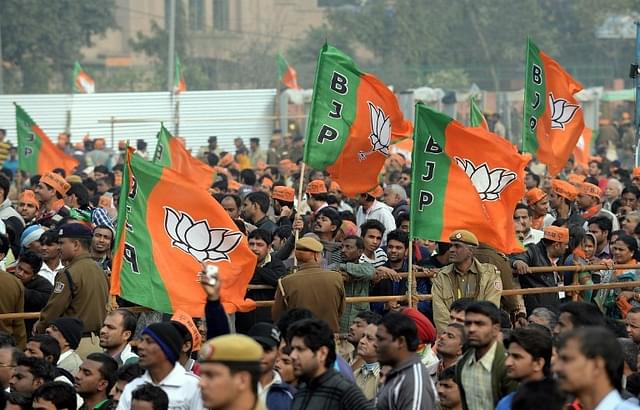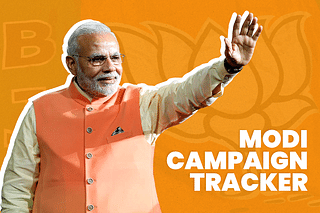Politics
How To Read The ABP News Poll That Shows NDA Actually Increasing Vote Share
R Jagannathan
Jan 28, 2016, 07:17 PM | Updated Feb 12, 2016, 05:23 PM IST
Save & read from anywhere!
Bookmark stories for easy access on any device or the Swarajya app.

2019 is still far away. If NDA can engineer an economic upturn where job growth is visible, it can still hope to at least maintain something like its 2014 performance.
What is one to make of the ABP News-Nielsen poll published on Republic Day, which suggests that not only will the NDA come back to power with 301 seats (a 38-seat drop from May 2014), but its vote share will actually increase from 38 percent to 43 percent.
The results certainly seem to fly in the face of the general narrative of a government under continual siege, and which has resoundingly lost two major state elections (Delhi and Bihar) and suffered some reverses in bypolls or local body elections in other states (Madhya Pradesh, Gujarat, etc). With every TV channel worth its salt talking up the “intolerance” debate, and with every incident (the Rohith Vemula suicide being only the latest) being milked for its anti-Modi, anti-BJP potential, one would have expected the polls to show a steeper decline for the NDA.
Is the poll wrong? We obviously can’t give a straight yes or no answer to that one (we have to wait for more polls to learn if the Nielsen one was flawed), but we can still draw tentative conclusions from its findings.
First, the level of print and TV media cacophony is no indicator of the nation’s mood. The public discourse may influence voter behaviour, but it is not decisive.
Second, there is no real contradiction between the fact that the NDA’s seats go down from 339 to 301 even while its vote share goes up. This can largely be explained by both an opposition consolidation against the NDA, and the broader rise of the BJP as the country’s largest party. This is what we saw in Bihar; the BJP lost heavily in seat count, but it also became the single largest party in the state by vote share. Its gains in strength are still sub-optimal in terms of seats, but the gains are clearly there.
Third, we are also underestimating the Modi impact in a national election by taking Bihar and Delhi as straws in the wind. The fact is Bihar and Delhi were lost by the BJP for reasons that were state-specific. In neither state did the party have a face to project against popular incumbents against whom there was no voter antipathy. The BJP simply did not have a leader to project against Arvind Kejriwal or Nitish Kumar. Using Modi in a state election, when he is not a contender for the top job there, is of marginal utility.
On the national stage, though, the reverse is true. Modi towers above everyone else, and since he has done almost nothing wrong politically or economically (he may have been less bold that he need have been, but that is another story), it is difficult to see him slide too much in a presidential-style national election. For that, he has to screw up big time, and that seems unlikely after the reverses in Bihar and Delhi.
Fourth, there could be problems with the sampling in the ABP News-Nielsen poll. It was carried out during 8-13 January across 109 parliamentary constituencies, with a sample size of over 16,000. This is not a bad sample size to obtain a broad national mood, but it could go horribly wrong in a first-past-the-post electoral system, where anything above 30 percent vote share can fetch you (or lose you) many seats in a multi-cornered contest. If the seat projections are to hold in 2019, there would have to be a reasonable division of anti-Modi votes, especially in states like Bihar and Uttar Pradesh. If, for example, Mayawati and the Congress team up, there could be a significant shift in voter behaviour. The Nitish-Lalu-Congress tie up worked wonders in Bihar, and if it holds in 2019, there will be a sharp drop in the BJP’s seat share.
Put another way, two conclusions are possible right now: Modi will continue to remain a factor in 2019, and his popularity will matter even more in the next election than in the past. As long as he does not goof up big time. Secondly, his success will depend on how divided the opposition to him remains.
The BJP’s ability to win a majority, either on its own or in an alliance will need the right caste and regional party alliances – in all regions. It’s constant battles with the Shiv Sena in Maharashtra and the break-up of its Tamil Nadu alliance may not be good for it. It should cultivate the AIADMK in Tamil Nadu and the BJD in Odisha.
It is also obvious that it may not be able to repeat its feat in UP where its alliance won 73 seats in 2014. Ditto for Bihar. It surely cannot repeat its cent-per-cent success rates in its backyard states of Gujarat and Rajasthan, and the near total victories in Madhya Pradesh and Chhattisgarh.
It should make some gains in the south and the east, but these may not be enough to make up for losses in the north and west. So it is reasonable to speculate that even with a higher national vote share, and its emergence as the main pole of national politics, it may not get a majority on its own in 2019.
On the other hand, 2019 is still far away. If it can engineer an economic upturn where job growth is visible, it can still hope to at least maintain something like its 2014 performance.
In short: it’s the economy, stupid!
Save & read from anywhere!
Bookmark stories for easy access on any device or the Swarajya app.
Jagannathan is Editorial Director, Swarajya. He tweets at @TheJaggi.
Support Swarajya's 50 Ground Reports Project & Sponsor A Story
Every general election Swarajya does a 50 ground reports project.
Aimed only at serious readers and those who appreciate the nuances of political undercurrents, the project provides a sense of India's electoral landscape. As you know, these reports are produced after considerable investment of travel, time and effort on the ground.
This time too we've kicked off the project in style and have covered over 30 constituencies already. If you're someone who appreciates such work and have enjoyed our coverage please consider sponsoring a ground report for just Rs 2999 to Rs 19,999 - it goes a long way in helping us produce more quality reportage.
You can also back this project by becoming a subscriber for as little as Rs 999 - so do click on this links and choose a plan that suits you and back us.
Click below to contribute.





